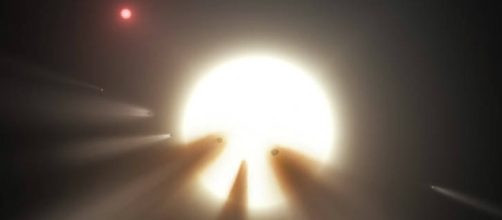Did NASA discover an alien megastructure star more than 1,400 light years away? That's the intriguing question brought up by findings from its Kepler Mission after observing a distant star over a four year period.NASA's Kepler Mission is an observatory mission with the express purpose of finding earth-like planets outside our solar system. As such, it observed a star called KIC 8462852 -- aka Tabby's Star -- for four years between 2009 and 2013. KIC 8462852 is what is known as an "F-type" star, located in the constellation called Cygnus in the Western tradition.
The initial 'alien megastructure' sensation
On analyzing the data, NASA scientists noticed inexplicable changes in the fluctuations of light that occurred on two occasions in 2011 and 2013. In both instances, the star's light became dimmer in a dramatic fashion -- one the researchers had never seen before. What they had observed was something that passed in front of the star, temporarily blocking its light waves.But what could possibly be large -- and quick -- enough to block out the light of astar to that degree?
Initial theories included a cluster of comets or fragments from an asteroid or even planet break up. NASA scientists believed the most likely theory would be a cluster or "family" of cold temperature comets circling KIC 8462852 in an elongated, eccentric shaped orbit.
The finding made news when the paper was published about a year ago.
According to a report in Gizmodo, however, others have another explanation: alien megastructures. Jason Wright, an astronomer at Penn State, and his team were among the proponents of the theory. A real life Death Star-like spacecraft? A planet-sized alien structure?
Naturally, the internet loved the idea.
KIC 8462852, aka Tabby's star, is dimming at an incredible rate and we don't know why. https://t.co/Ct9RtrXnxt pic.twitter.com/eqTgLwWsWJ
— Science Channel (@ScienceChannel) September 9, 2016
The deepening mystery of KIC 8462852
A study just published in August 2016, however, blows all their theories out of the water.
Tabby's Star dimmed at such an incredibly fast rate that it couldn't be explained by comets, or the so-called "distorted star" theory. Tabby's Star sometimes dims by as much as 20 percent and has actually been diminishing in light overall for the entire 4 year period of observation. Kepler was looking at some 500 stars in that same area of the sky and KIC 8462852's behavior was unique.
The SETI Institute -- or Search for Extraterrestrial Intelligence Institute -- is a private non-profit devoted to scientific research of you-know-who. Its members are respected members of the scientific community and the Institute has worked with NASA among many other organizations. SETI scientists speculate that the orbiting structure which dims the star's light in such an eccentric fashion may be a series of technologically advanced solar panels, or a very large spacecraft.
To investigate the theory, SETI's scientists are using the Allen Telescope Array -- a large network of small dishes -- to look for corresponding radio signals.
Astronomer Tabby Boyajian, who found the star, successfully crowdfunded the cash to take a full year to observe the star that bears her name in the hopes that it repeats the phenomenon.

